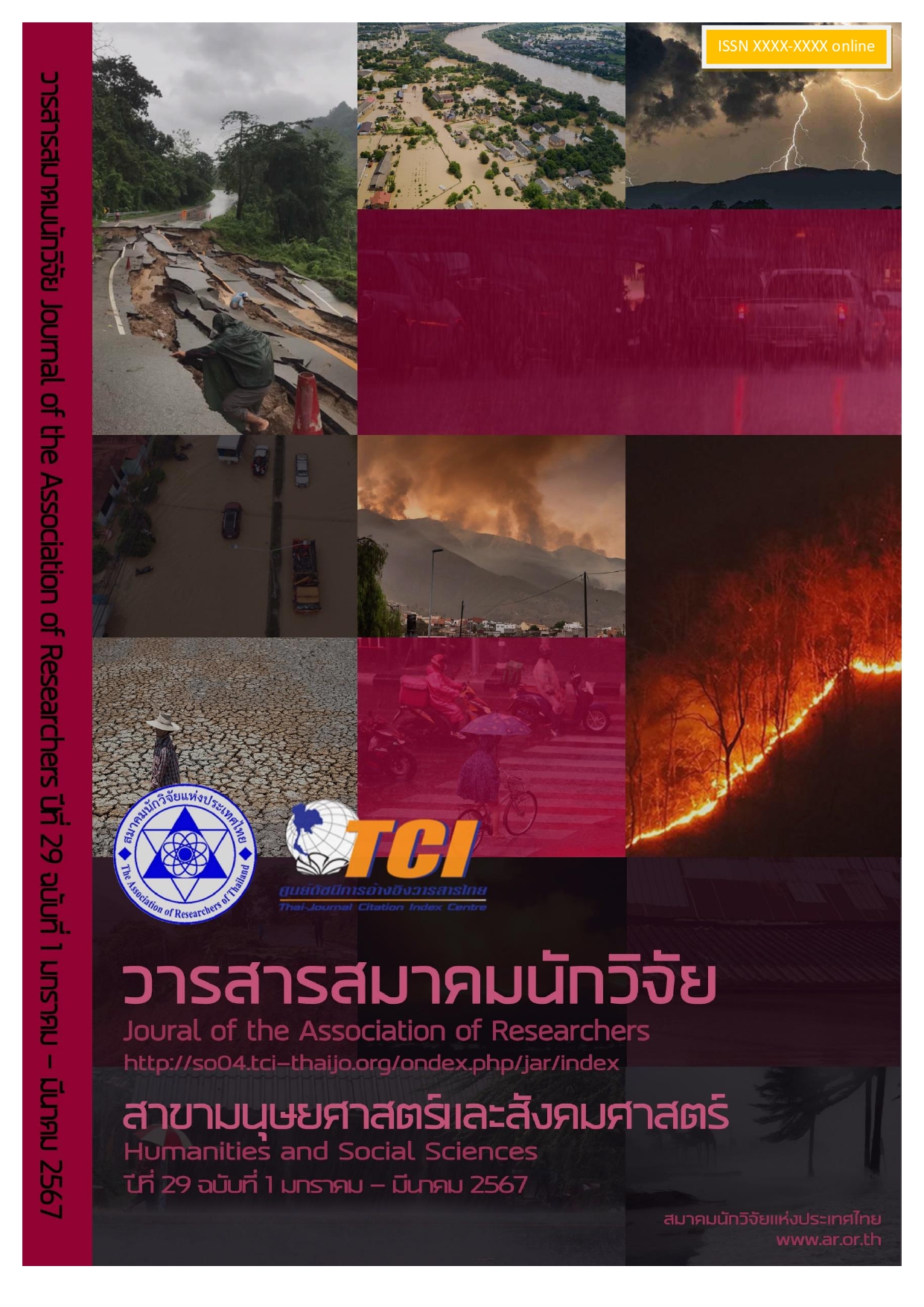The Art of Crafting Scholarly Literature with Creative Ingenuity
Main Article Content
Abstract
This article aims to present the principles of academic writing accurately according to academic standards, providing readers with clear and easily understandable information. It explicitly explains the characteristics of academic misconduct in 11 distinct forms. Furthermore, it describes the features of high-quality and interesting academic articles, enabling readers to apply them appropriately in their own work. This serves as a guide for gathering knowledge from various sources and using it appropriately within the context of each article. It also discusses the types of images suitable for disseminating academic work and the process of checking for plagiarism using popular computer programs such as plagiarism checkers and Turnitin. By incorporating the principles and concepts outlined in this article, along with methods for checking for duplications, your academic articles will be accepted for publication, allowing researchers or scholars to reference or utilize them freely without concerns about literary theft. Plagiarism is considered a damaging act with significant repercussions. By analyzing data published through the electronic media of the Chiang Mai University Library “Turnitin, a tool for checking duplicates and academic plagiarism” For academic development. Therefore, learning and adhering to correct academic writing principles, along with utilizing plagiarism detection tools, are crucial in creating high-quality and secure literary works.
Article Details

This work is licensed under a Creative Commons Attribution-NonCommercial-NoDerivatives 4.0 International License.
บทความที่ปรากฏในวารสารนี้ เป็นความรับผิดชอบของผู้เขียน ซึ่งสมาคมนักวิจัยไม่จำเป็นต้องเห็นด้วยเสมอไป การนำเสนอผลงานวิจัยและบทความในวารสารนี้ไปเผยแพร่สามารถกระทำได้ โดยระบุแหล่งอ้างอิงจาก "วารสารสมาคมนักวิจัย"
References
กัญจนา บุณยเกียรติ และ ประไพพิศ มงคลรัตน์. (2556). การลักลอกงานวิชาการและวรรณกรรม (Plagiarism). (พิมพ์ครั้งที่ 2). กรุงเทพฯ : โรงพิมพ์แห่งจุฬาลงกรณ์มหาวิทยาลัย.
ประกาศ ก.พ.อ. (2563). หลักเกณฑ์และวิธีการพิจารณาแต่งตั้งบุคคลให้ดำรงตำแหน่ง ผู้ช่วยศาสตราจารย์ รองศาสตราจารย์ และศาสตราจารย์ พ.ศ. 2563.
พร้อมภัค บึงบัว และคณะ. (2567). การเขียนบทความวิชาการและการเขียนบทความการวิจัย. เข้าถึงเมื่อ 27 กุมภาพันธ์ 2567 เข้าถึงที่ https://www.nidtep.go.th/2017/publish/doc/20180515.pdf.
ไพโรจน์ ลีลาภัทรกิจ. (2567). คู่มือการใช้งานระบบอักขราวิสุทธิ์ เพื่อการตรวจสอบการลักลอกผลงาน ทางวิชาการ. บริษัท อินสไปก้า จำกัด : เข้าถึงเมื่อ 27 กุมภาพันธ์ 2567 เข้าถึงที่ https://www2.nmu.ac.th/th/wp-content/uploads/2018/06/BW-to-Searchable-PDF_1_20130101000621930.pdf.
ทิวนภา ศิริพรหม และ สมฤดี คงพุฒ. (2560). กลวิธีเพื่อหลีกเลี่ยงการคัดลอกงานเขียนทางวิชาการ: กรณีศึกษานักศึกษาระดับปริญญาโท สาขาวิชาการสอนภาษาอังกฤษ, วารสารมนุษยศาสตร์ มหาวิทยาลัยนเรศวร,วารสารมนุษยศาสตร์ มหาวิทยาลัยนเรศวร, 14(2), 47-60.
สำนักงานคณะกรรมการวิจัยแห่งชาติ. (2560). คู่มือมาตรฐานการเผยแพร่ผลงานวิจัยและผลงานทางวิชาการ (พิมพ์ครั้งที่ 4). กรุงเทพฯ : โรงพิมพ์แห่งจุฬาลงกรณ์มหาวิทยาลัย.
สุพรรณ ฟู่เจริญ. (2557). การคัดลอกผลงานตนเอง (Self Plagiarism). วารสารเทคนิคการแพทย์และกายภาพบำบัด. คณะเทคนิคการแพทย์ มหาวิทยาลัยขอนแก่น, (26), (กันยายน-ธันวาคม), หน้า 209-210.
ห้องสมุดมหาวิทยาลัยเชียงใหม่. (2566). Turnitin เครื่องมือตรวจสอบความซ้ำซ้อนและการคัดลอกผลงานทางวิชาการ. เข้าถึงเมื่อ 1 กรกฎาคม 2566 เข้าถึงที่ https://library.cmu.ac.th/HtmlDetail /Detail/183/main.
ห้องสมุดมหาวิทยาลัยเชียงใหม่. (2567). การใช้งานโปรแกรม Turnitin for Student. เข้าถึงเมื่อ 27 กุมภาพันธ์ 2567 เข้าถึงที่ https://w1.med.cmu.ac.th/library/files/Manual_Turnitin-for-Student.pdf.
เว็บไซต์
Translates in Thai Reference
Announcement of the Council of State. (2020). Criteria and Procedures for the Appointment of Assistant Professors, Associate Professors, and Professors in 2020, p. 23.
Bunyakiat K.& Pisamkratana. P. (2013). Plagiarism. (2nd ed.). Bangkok: Chulalongkorn University Printing House.
Buabua, P. et al. (2014). Academic Article Writing and Research Article Writing. Retrieved on February 27, 2024, from https://www.nidtep.go.th/2017/publish/doc/20180515.pdf.
Fucharoen. S. (2014). Self-Plagiarism. Journal of Medical Technology and Physical Therapy. Faculty of Medical Technology, Khon Kaen University. (26), (September-December), pp. 209-210.
Leelapatgij. P. (2014). User Manual for Plagiarism Detection System for Academic Work. InSpica Co., Ltd. Retrieved on February 27, 2024, from https://www2.nmu.ac.th/th/wp-content/uploads/2018/06/BW-to-Searchable-PDF_1_20130101000621930.pdf.
Medical Library, Chiang Mai University. (2024). Turnitin: Plagiarism and Academic Work Duplication Checking Tool. Retrieved on July 1, 2014, from https://library.cmu.ac.th/HtmlDetail/Detail/183/main.
Medical Library, Chiang Mai University. (2024). Using Turnitin for Student Program. Retrieved on February 27, 2024, from https://w1.med.cmu.ac.th/library/files/Manual_Turnitin-for-Student.pdf.
National Research Council of Thailand. (2017). Standard Guidelines for Publishing Research Papers and Academic Works. (3rd ed.). Bangkok: Chulalongkorn University Printing House.
Siriprom, T.& Khongput, S. (2017). Strategiesto AvoidPlagiarism in Academic Writing: A Case Study of Master’s Students in Teaching English, Journal of Humanities. 14(2), 47-60.


